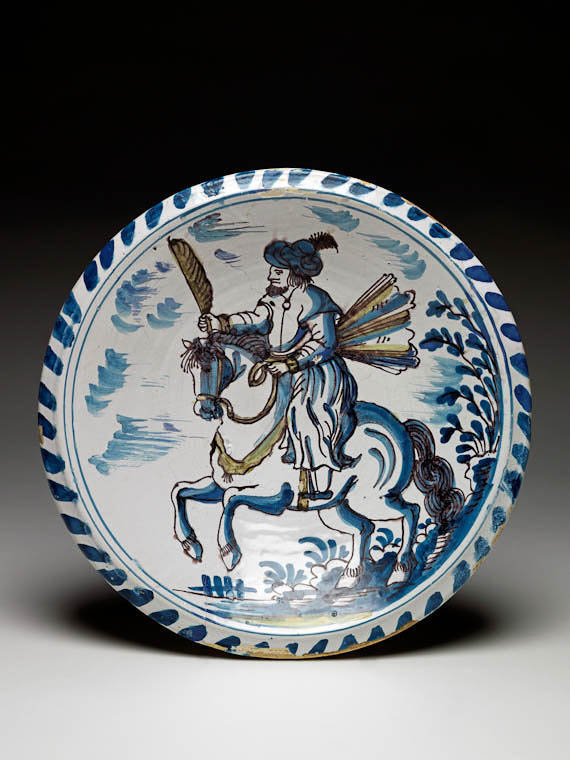Current Location: In storage
Titles
Dish: a horseman
Maker(s)
Pottery:
Unidentified Netherlandish pottery
(Probably)
Pottery:
unidentified English pottery
(Possibly)
Entities
-
Dish
- charger
- blue-dash charger
Categories
Description
Tin-glazed earthenware painted in blue, dull pale yellow, and manganese-purple with a Turkish horseman riding to the left surrounded by two blue concentric circles, and blue dashes on the edge.
Buff earthenware, tin-glazed white on the front and painted in blue, dull pale yellow and manganese-purple, the reverse possibly coated with a pale slip before application of greenish-yellow, lead-glaze with dark radiating streaks. Circular with deep curved sides and slightly everted rim, standing on a footring. The front is decorated with a horseman (probably a Turk) riding to the left. He wears a turban and a long gown with a sash or cloak billowing out om a fan-shape behind him, and holds a feather-like object in his right hand. Round the rim there are two blue concentric circles and blue dashes.
Notes
History note: Mr Malcolm Stoner, London, from whom purchased for £45 on 28 March 1927 by Dr J.W.L. Glaisher, Trinity College, Cambridge
Legal notes
Dr J.W.L. Glaisher Bequest
Measurements and weight
Diameter: 34.3 cm
Diameter: 13½ in
Height: 7 cm
Height: 2 ¾ in
Acquisition and important dates
Method of acquisition: Bequeathed
(1928-12-07)
by
Glaisher, J. W. L., Dr
Dating
17th Century, Late
Circa
1675
CE
-
1700
CE
Note
The origin of this dish is uncertain, it could be Dutch, possibly Friesian, or English
People, subjects and objects depicted
Components of the work
Decoration
composed of
high-temperature colours
( blue, yellowish-green, and manganese-purple)
Back
composed of
lead-glaze
( greenish)
Front
composed of
tin-glaze
Foot
Materials used in production
Earthenware
Techniques used in production
Press-moulding
: Buff earthenware, the front tin-glazed and painted in blue, dull yellow and manganese-purple; the reverse covered with greenish lead-glaze which has crazed, probably over pale slip
Inscription or legends present
Inscription present: The above text was centred so that it formed a rounded lozenge shape
- Text: A VERY RARE
LAMBETH DELFT CHARGER
Painted in colours with an equestrian portrait of
a man holding a quill pen. This probably is a represen-
tation of Sir Francis Windebank fleeing for his life to
France.
SIR FRANCIS WINDEBANK (1582-1645).
English Secretary of State and was the only son of Sir Thomas Windebank
of Hougham, Lincs, who owed his advancement to the Cecil family. Francis entered
St John's College, Oxford, in 1599 coming there under the influence of Laud. After a
few years of continental travel (1605-1608), he was employed for many years in minor public
office, and became Clerk of the Council. In June 1632 he was appointed by Charles I Secretary
of State in succession to Lord Dorchester, his senior colleague being Sir John Coke, and he was
knighted. Windebank's efforts as Treasury Commissioner in 1635 to shield some of those guilty
of corruption, led to a breach with Archbishop Laud, and next year he was for a time dis-
graced for issuing an order for the conveyance of Spanish money to pay the Spanish
troops in the Netherlands. In July 163 (sic) he urged upon the King instant war with
the Scots, and in 1640 when tumults were breaking out in England, he sent an
appeal from the Queen to the Pope for money and men.
Elected March 1640 Member of the S rt Parliament for Oxford University,
and entered Long Parliament in October as member for Corfe.
In December the House learnt that he had signed letters
of grace to recusant priests and Jesuits, and summoned
him to answer the charge, but with the King's
connivance he fled to France and died in
Paris on 1st.Sept.1646.
- Location: Stuck onto the back until 2002
- Method of creation: Typed on white paper
- Type: Label
References and bibliographic entries
Related exhibitions
Identification numbers
Accession number: C.1406-1928
Primary reference Number: 71938
Old object number: 4973
Stable URI
Audit data
Created: Saturday 6 August 2011
Updated: Tuesday 30 April 2024
Last processed: Tuesday 15 July 2025
Associated departments & institutions
Owner or interested party:
The Fitzwilliam Museum
Associated department:
Applied Arts





